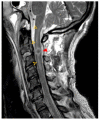Skimboarding: An Increasingly Recognized Cause of Life-Threatening Spinal Cord Injury
- PMID: 35145812
- PMCID: PMC8811467
- DOI: 10.7759/cureus.20915
Skimboarding: An Increasingly Recognized Cause of Life-Threatening Spinal Cord Injury
Abstract
Skimboarding is a sport that combines elements from aquatic and terrestrial sports and has gained popularity with increased riskier maneuvers. Spinal cord injuries associated with this sport have rarely been reported. Here we present a case of a previously healthy 44-year-old male with a life-threatening C2/C3 fracture and dislocation after a skimboarding fall. Traumatic facet dislocations in the cervical spine are usually consequent to high-energy transmission injuries, so it is difficult to explain the mechanism of injury in this clinical case. As this sport's practice continues to grow, our purpose is to emphasize that these injuries may occur with irreversible consequences as most of the damage occurs at the time of presentation, so the first step is to alert athletes and the community to prevent them.
Keywords: life-threatening; skimboarding; spinal cord; traumatic cervical spine injury; water sport injuries.
Copyright © 2022, Mota et al.
Conflict of interest statement
The authors have declared that no competing interests exist.
Figures





References
-
- Prevalence of cervical spinal injury in trauma. Milby AH, Halpern CH, Guo W, Stein SC. Neurosurg Focus. 2008;25:0. - PubMed
-
- Emergency neurological life support: traumatic spine injury. Stein DM, Knight WA IV. Neurocrit Care. 2017;27:170–180. - PubMed
-
- Distribution and patterns of blunt traumatic cervical spine injury. Goldberg W, Mueller C, Panacek E, Tigges S, Hoffman JR, Mower WR. Ann Emerg Med. 2001;38:17–21. - PubMed
-
- Trauma: spinal cord injury. Eckert MJ, Martin MJ. Surg Clin North Am. 2017;97:1031–1045. - PubMed
-
- The importance of maintaining spinal precautions. Freeborn K. Crit Care Nurs Q. 2005;28:195–199. - PubMed
Publication types
LinkOut - more resources
Full Text Sources
Research Materials
Miscellaneous
